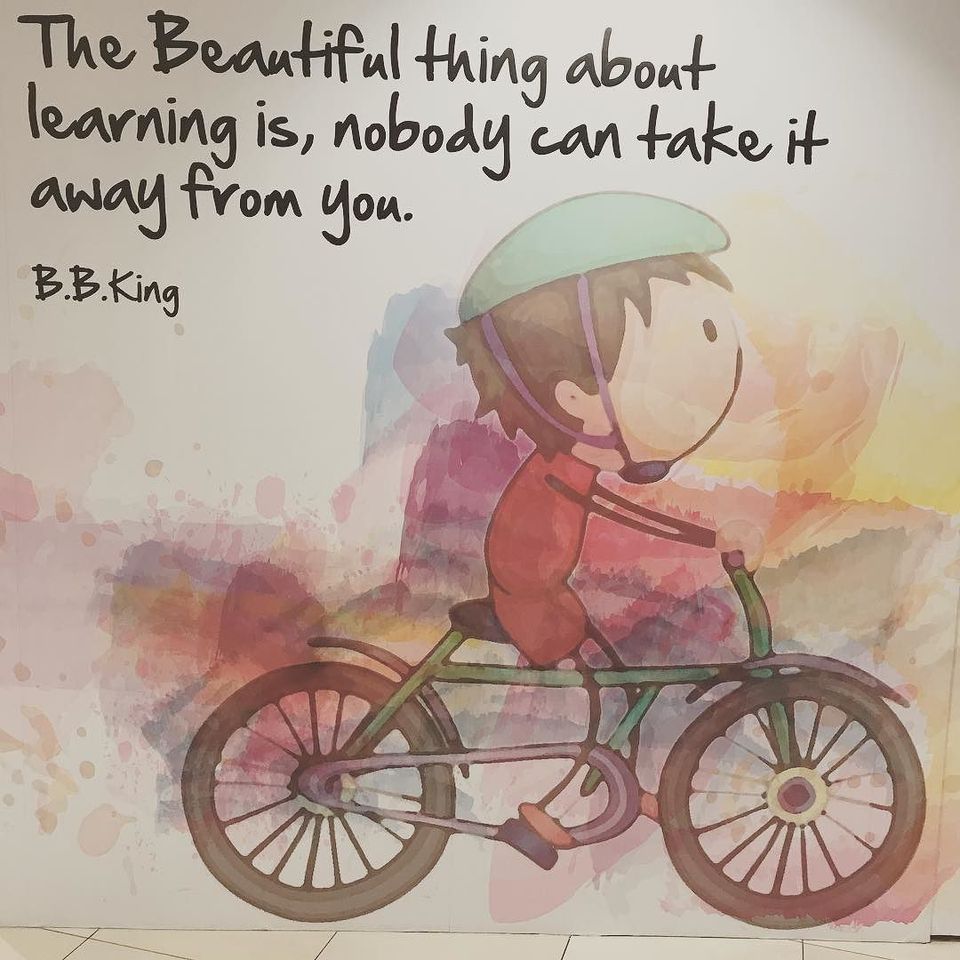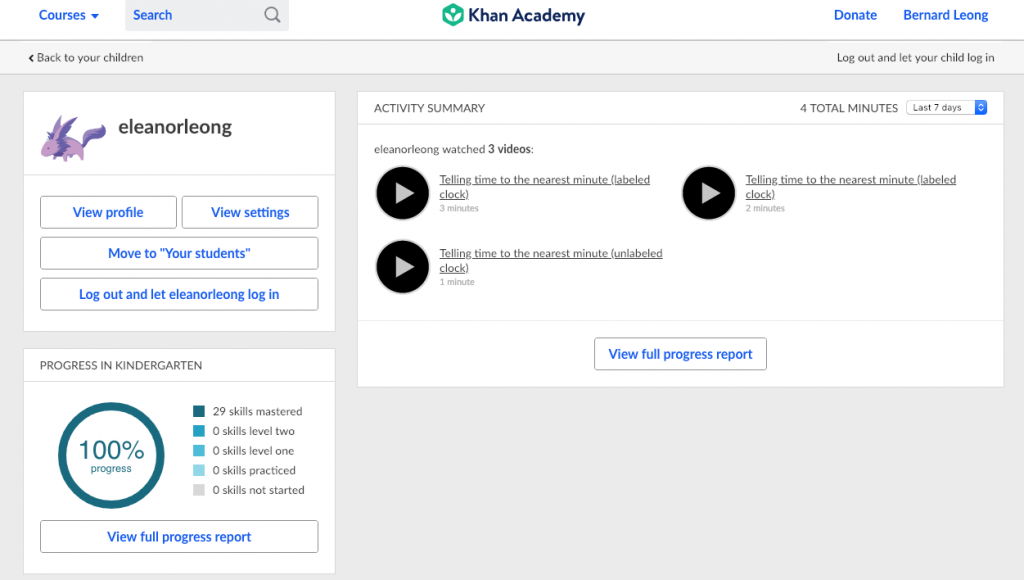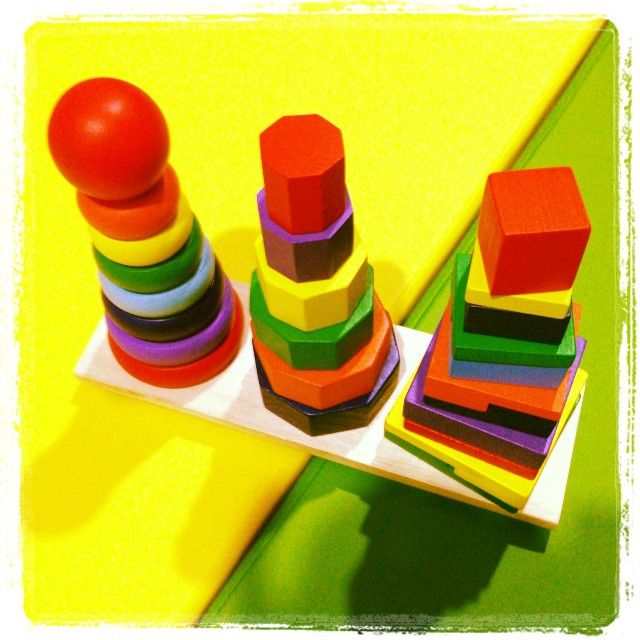What have I learned so far from taking my daughter through Khan Academy?

Recently, my daughter has started her first year in primary school. As she was fully educated in a pure Montessori pre-school, I was curious to see how an online education would work for her. So I started her with Khan Academy last year. Here are the lessons which I have learned as a parent and why Khan Academy may still have a long way to go as an online tool to educate kids over the past year.
Let me first share the entire process of how we started. I have set up a Mac desktop computer for my daughter at home early last year. In the process, I have taught her basic procedures such as turning it on and shutting it down, get her to key in password for her own account on the computer. On the first occasion, I got her to turn on the web browser and brought her to Khan Academy. I registered her with a user account. In parallel, I have also registered a parent account so that I can monitor her progress and at the same time and check out the courses myself.
Let me do a quick introduction to Khan Academy. It is a non-profit organization created in 2008 by Salman Khan with the goal of creating a set of online tools that help educate students all the way to university. Salman Khan originally used online videos to educate his niece on mathematics and gradually expand the curriculum to other areas of learning from English (American English) to computer programming. Of course, it’s free and anyone can access it anywhere. It will be interesting if I can get Eleanor to be interested in STEM (Science, Technology, Engineering & Mathematics) subjects.
How did we start? The easiest way is to follow the mathematics course by grade. Eleanor studied in a pure Montessori pre-school in Singapore and it’s the only one out of the two with all the teachers properly certified with international credentials. We would love to let her continue but it is unfortunately by law that we need to send her to a local primary school at the age of 7. My wife and I have decided that our kids unlike us, have better access to knowledge out there via the Internet. Hence the only two important elements we would want them to gain through the course of their education are just the following: (a) they must have the passion and enjoyment of continuous learning because the knowledge are already available everywhere and evolving at exponential rate, (b) the ability to learn fast and be critical about what they are learning.
By the time we have started, Eleanor was already taught in her school with basic arithmetic and geometry. So, we went through the online course, typically going through 20 minutes (equivalent to four short topics) of online video, and followed by a small assessment test about 7 questions. We originally started with the iPad, but the user experience on the Khan Academy mobile app was just not up to standard. I have switched her to a desktop after three lessons. As we progressed, Khan Academy has a unit test component and a final test that will see if she has passed the entire topic block. Through going through some nights in the weekdays and then sometimes intensely about one to two hours over weekend or during my annual leave period, we have completed a reasonable amount of early mathematics courses for kids. In the process of doing this, I have added other tools on her table other than the computer: an abacus, a notepad, pencil, ruler and eraser. Sometimes, we solve the problem on paper before transferring the final answer to the online dialog box.

To be fair, her Montessori education imbued her with a very strong foundation in mathematics particularly in geometry which gave her a relatively easy advantage in completing the course topics. Based on her pre-school education, she was an equivalent of at least a grade 2 in the US education system with some parts of grade 3 (which includes multiplication and division).
What have I learned from working with her on Khan Academy?
- The online education from Khan Academy is meant for children in advanced economies and it will have to do more for developing or frontier economies: First, the parent or teacher who is guiding the child on Khan Academy, must have at least basic education and of course to access the content, both video and assessment, you must have at least a relatively high speed broadband. Remember the mobile app does not work very well and hence it is not likely that a child from an emerging economy such as Indonesia can access that knowledge base that easily. The basic criteria made the access to the online education limited to children within advanced economies such as Singapore, Japan, Korea or major cities in Asia Pacific. The other implication is that there should be challengers to Khan Academy in the emerging markets because there are both language and access barriers for kids in those markets.
- Short spurts of video and gamification of the platform works to spur her on: She enjoyed the videos as they are relatively short. It’s the short attention time spent for kids on digital devices. Sometimes, if she’s tired, she just watched two for the day and skipped the rest. I credit this to Salman Khan in how he has approached teaching these topics online and he has made it easy and nice to watch and listen. Other times, she will try to do as much as possible. I notice that she was eager to go to the next block of the mathematics course quickly, and of course, the badges of achievement boosted her confidence and pushed her to do more. I suspect that there is a degree of gamification going on in the platform. Typically, I will listen to the video along with her, and guide her carefully with some nuances on the topic.
- The parent has to let go when it comes to exercises and assessments: As the platform has a strong assessment component, I started to help her from the start and gradually realized that I was being too helpful. So, I have to do the hard thing by taking a step back. I told her that she can work on the problem while I do something else. She resisted and it created some tension between us. The rationale is that if you help her too much, she may not know how to solve the problem herself. I realized that when we started to solve mathematics problems involving words and require logic as part of the process. Yes, you cannot be a Tiger mother or father when it comes to this. The dependency of having the parent there to help should gradually go away. Believe me, I am still struggling with her on this all the time, but we have to gradually let go.
- She will gradually start exploring other courses: Eleanor has asked me randomly at times to go to other courses instead of mathematics. We have started with basic programming which used javascript as a starting language, and American English grammar course (and she really liked this one for some reason), which to my surprise, helped me in re-learning the basics of the language again. Gradually, she wanted to learn how to type on a keyboard fast (and this one from BBC is excellent), and I have started searching to find an appropriate typing course for her as well. As I have used a geometric stacker and taught her how to solve the Tower of Hanoi problem with 3-7 blocks when she was four, she was able to do one small part of the course involving computer algorithms.

Unlike most parents who have kids that want to turn on the digital devices all the time, the greatest challenge for me is to get her to turn on the computer and do it herself. She insisted that I am always there when that happens.
Overall, online learning offers a different way to how we can educate our kids. However, after attending and completing just one online course with a considerable amount of effort, there is still much to be done. Despite the promises of online education having the ability to teach many at scale, there are still challenges ahead involving certification and signaling.